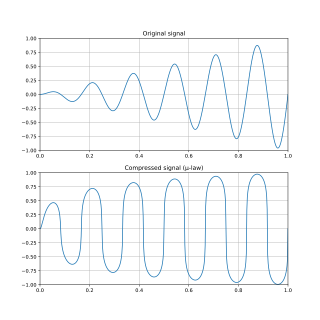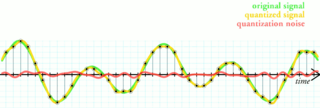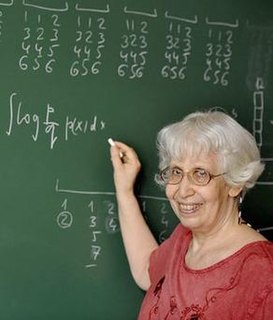Related Research Articles

In electronics, an analog-to-digital converter is a system that converts an analog signal, such as a sound picked up by a microphone or light entering a digital camera, into a digital signal. An ADC may also provide an isolated measurement such as an electronic device that converts an analog input voltage or current to a digital number representing the magnitude of the voltage or current. Typically the digital output is a two's complement binary number that is proportional to the input, but there are other possibilities.

In telecommunication and signal processing, companding is a method of mitigating the detrimental effects of a channel with limited dynamic range. The name is a portmanteau of the words compressing and expanding, which are the functions of a compander at the transmitting and receiving end respectively. The use of companding allows signals with a large dynamic range to be transmitted over facilities that have a smaller dynamic range capability. Companding is employed in telephony and other audio applications such as professional wireless microphones and analog recording.

A delta modulation is an analog-to-digital and digital-to-analog signal conversion technique used for transmission of voice information where quality is not of primary importance. DM is the simplest form of differential pulse-code modulation (DPCM) where the difference between successive samples is encoded into n-bit data streams. In delta modulation, the transmitted data are reduced to a 1-bit data stream. Its main features are:

Quantization, in mathematics and digital signal processing, is the process of mapping input values from a large set to output values in a (countable) smaller set, often with a finite number of elements. Rounding and truncation are typical examples of quantization processes. Quantization is involved to some degree in nearly all digital signal processing, as the process of representing a signal in digital form ordinarily involves rounding. Quantization also forms the core of essentially all lossy compression algorithms.
A cryptosystem is considered to have information-theoretic security if the system is secure against adversaries with unlimited computing resources and time. In contrast, a system which depends on the computational cost of cryptanalysis to be secure is called computationally, or conditionally, secure.
Differential pulse-code modulation (DPCM) is a signal encoder that uses the baseline of pulse-code modulation (PCM) but adds some functionalities based on the prediction of the samples of the signal. The input can be an analog signal or a digital signal.
Delta-sigma modulation is a method for encoding analog signals into digital signals as found in an analog-to-digital converter (ADC). It is also used to convert high bit-count, low-frequency digital signals into lower bit-count, higher-frequency digital signals as part of the process to convert digital signals into analog as part of a digital-to-analog converter (DAC).

In electrical engineering and computer science, Lloyd's algorithm, also known as Voronoi iteration or relaxation, is an algorithm named after Stuart P. Lloyd for finding evenly spaced sets of points in subsets of Euclidean spaces and partitions of these subsets into well-shaped and uniformly sized convex cells. Like the closely related k-means clustering algorithm, it repeatedly finds the centroid of each set in the partition and then re-partitions the input according to which of these centroids is closest. In this setting, the mean operation is an integral over a region of space, and the nearest centroid operation results in Voronoi diagrams.

Spiking neural networks (SNNs) are artificial neural networks that more closely mimic natural neural networks. In addition to neuronal and synaptic state, SNNs incorporate the concept of time into their operating model. The idea is that neurons in the SNN do not transmit information at each propagation cycle, but rather transmit information only when a membrane potential – an intrinsic quality of the neuron related to its membrane electrical charge – reaches a specific value, called the threshold. When the membrane potential reaches the threshold, the neuron fires, and generates a signal that travels to other neurons which, in turn, increase or decrease their potentials in response to this signal. A neuron model that fires at the moment of threshold crossing is also called a spiking neuron model.
Pulse-code modulation (PCM) is a method used to digitally represent sampled analog signals. It is the standard form of digital audio in computers, compact discs, digital telephony and other digital audio applications. In a PCM stream, the amplitude of the analog signal is sampled regularly at uniform intervals, and each sample is quantized to the nearest value within a range of digital steps.
Quantum block codes are useful in quantum computing and in quantum communications. The encoding circuit for a large block code typically has a high complexity although those for modern codes do have lower complexity.

Yasuo Matsuyama is a Japanese researcher in machine learning and human-aware information processing.
The term Blahut–Arimoto algorithm is often used to refer to a class of algorithms for computing numerically either the information theoretic capacity of a channel, the rate-distortion function of a source or a source encoding. They are iterative algorithms that eventually converge to one of the maxima of the optimization problem that is associated with these information theoretic concepts.

An audio coding format is a content representation format for storage or transmission of digital audio. Examples of audio coding formats include MP3, AAC, Vorbis, FLAC, and Opus. A specific software or hardware implementation capable of audio compression and decompression to/from a specific audio coding format is called an audio codec; an example of an audio codec is LAME, which is one of several different codecs which implements encoding and decoding audio in the MP3 audio coding format in software.

Katalin Marton was a Hungarian mathematician, born in Budapest.
Directed information, , is an information theory measure that quantifies the information flow from the random process to the random process . The term directed information was coined by James Massey and is defined as
JPEG XS is an interoperable, visually lossless, low-latency and lightweight image and video coding system that targets mezzanine compression within any AV application. Applications of the standard include streaming high quality content for virtual reality, drones, autonomous vehicles using cameras, gaming, and broadcasting. In this respect, JPEG XS is unique, being the first ISO codec ever designed for this specific purpose. JPEG XS, built on core technology from both intoPIX and Fraunhofer IIS, is formally standardized as ISO/IEC 21122 by the Joint Photographic Experts Group with the first edition published in 2019. Although not official, the XS acronym was chosen to highlight the eXtra Small and eXtra Speed characteristics of the codec. Today, the JPEG committee is still actively working on further improvements to XS, with the second edition scheduled for publication and initial efforts being launched towards a third edition.
Orthogonal Time Frequency Space (OTFS) is a 2D modulation technique that transforms the information carried in the Delay-Doppler coordinate system. The information is transformed in the similar time-frequency domain as utilized by the traditional schemes of modulation such as TDMA, CDMA, and OFDM. It was first used for fixed wireless, and is now a contending waveform for 6G technology due to its robustness in high-speed vehicular scenarios.
Delay Doppler coordinates are coordinates typically used in a radar technology-inspired approach to measurement. When used in wireless communication, the Delay Doppler domain mirrors the geometry of the reflectors comprising the wireless channel, which changes far more slowly than the phase changes experienced in the rapidly varying time-frequency domain.
John Cronan Kieffer is an American mathematician best known for his work in information theory, ergodic theory, and stationary process theory.
References
- ↑ Du, Ke-Lin; Swamy, M. N. S. (2010), Wireless Communication Systems: From RF Subsystems to 4G Enabling Technologies, p. 483, ISBN 978-0-521-11403-5
- ↑ Daubechies, I.; Yilmaz, O. (2006), "Robust and Practical Analog-to-Digital Conversion With Exponential Precision", IEEE Transactions on Information Theory , 52 (8): 3533–3545, doi:10.1109/TIT.2006.878220, S2CID 15166166
- ↑ London Mathematical Society lecture note series, Volume 312 by Felipe Cucker, London Mathematical Society 2004 ISBN 0-521-54253-7 page 23.
- ↑ Daubechies, Ingrid; Gunturk, C. Sinan; Wang, Yang; Yilmaz, Özgür (2010). "The Golden Ratio Encoder". IEEE Transactions on Information Theory. 56 (10): 5097–5110. arXiv: 0809.1257 . doi:10.1109/TIT.2010.2059750. ISSN 0018-9448. S2CID 8513029.
- ↑ Ward, Rachel (2008), "On Robustness Properties of Beta Encoders and Golden Ratio Encoders", IEEE Transactions on Information Theory , 54 (9): 4324–4334, arXiv: 0806.1083 , doi:10.1109/TIT.2008.928235, S2CID 12926540
- ↑ Kohda, Tohru; Hironaka, Satoshi; Aihara, Kazuyuki (2009). "Negative Beta Encoder". arXiv: 0808.2548 [cs.IT].